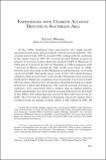Artículo
Experiences with current account deficits in Southeast Asia
Fecha
2008Resumen
In the 1990s, Southeast Asia experienced very rapid growth associated with large and persistent current account deficits. The episode lasted from 1990 to around 1996, ending with the outbreak of the Asian crisis in 1997–98. Current account deficits peaked at around 10 percent of gross domestic product (GDP) in Malaysia in 1995 and at 8 percent of GDP in Thailand in 1996 (compared with 7 percent in Mexico around the time of the peso crisis in 1994). Deficits were also large in the Philippines and Indonesia, at around 4 percent of GDP. During the crisis years of 1997–98, deficits became surpluses that persisted for years (in the Philippines this occurred much later). Malaysia’s surpluses rose to around 15 percent of GDP after its crisis, whereas they declined in Thailand (turning to a small deficit for a time) and Indonesia. The current account reversals to surpluses were associated with a sudden stop in capital inflows, which significantly exceeded current account deficits in the first half of the 1990s, but which had not recovered their previous levels by 2006.
Colecciones
Descargar


